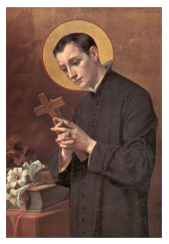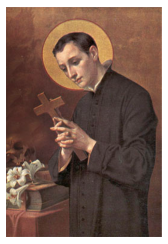
© Lorem ipsum dolor sit Nulla in mollit pariatur in, est ut dolor eu eiusmod lorem 2013
In 1596 John Ogilvie, aged 16, was registered, by Father William Crighton, as a
student at the Scots College of Douai, France, which had been moved at the
time to Louvain in Belgium. The college occasionally received students who
were not Catholics and among his instructors was Cornelius Lapide, (Cornelius
Van Der Steen) then a young Professor of Scripture and later to become a
great scholar. Poverty at the college meant that some students had to be
dispersed, and in 1598 Ogilvie was sent to the Scots Benedictine College at
Ratisbon, Bavaria, and in 1599 went on to the Jesuit College at Olmutz in
Bohemia, supported by a Papal bursary, and it is here that he became a
Catholic.
Having embraced the faith, John Ogilvie wanted to become a priest. The Jesuit
order was close to his heart and he traversed the Continent to achieve his aim. His application, along
with others, was deferred because of plague but he persisted and in 1599 was admitted to the Jesuit
order at Brunn in Moravia, by the Austrian Provincial, Father Ferdinand Albers. From there he was sent
to Graz in the Austrian Tyrol, where he made his first vows on the 26
th
of December 1601, and stayed
there until 1606, teaching grammar in the lower school and studying philosophy and science at the
university. He spent a time teaching at Vienna in 1605, and then returned to Olmutz in 1607 for more
studies.
In 1609, though not yet ordained, he was appointed, along with another young Scot, Father Green, to
the charge of encouraging devotion to Our Lady as a means of fortifying a faith that was under siege.
He achieved success and a Jesuit historian would later recount one Lenten exercise which saw Ogilvie
lead young pupils, after 5 a.m. Mass and Communion, in making a Way of the Cross through the streets
of the unfriendly city, carrying crosses and dressed in sacking, returning to the chapel to set their
crosses before the altar and lie prostrate in prayer for an hour.
In 1610 he received orders from Father Aquaviva to go to the French Province, and was sent back to
Paris. He travelled via Prague and was joined by his uncle Father George Elphinstone. He was ordained
a priest of the Society of Jesus in 1610, at the age of 31. His prayer had been answered.
The newly-ordained Father Ogilvie was appointed confessor to the students at Rouen where he met
priests exiled from Scotland for saying Mass or ministering to people, and realising the heavy burden of
Catholics in his native land he longed to return there. He applied to his Jesuit superiors for permission
to go home. Twice he was refused, but his persistence eventually paid off.
Then there was no other Jesuit priest in Scotland, almost no priests at all, so this represented an
extraordinary vote of confidence in this inexperienced priest.
It was a dangerous mission.
Path to Priesthood
St John Ogilvie



© Lorem ipsum dolor sit Nulla in mollit pariatur in, est ut dolor
eu eiusmod lorem 2013
St John Ogilvie
Path to Priesthood
In 1596 John Ogilvie, aged 16, was registered, by Father
William Crighton, as a student at the Scots College of Douai,
France, which had been moved at the time to Louvain in
Belgium. The college occasionally received students who were
not Catholics and among his instructors was Cornelius Lapide,
(Cornelius Van Der Steen) then a young Professor of Scripture
and later to become a great scholar. Poverty at the college
meant that some students had to be dispersed, and in 1598
Ogilvie was sent to the Scots Benedictine College at Ratisbon,
Bavaria, and in 1599 went on to the Jesuit College at Olmutz in
Bohemia, supported by a Papal bursary, and it is here that he
became a Catholic.
Having embraced the faith, John Ogilvie wanted to become a
priest. The Jesuit order was close to his heart and he
traversed the Continent to achieve his aim. His application,
along with others, was deferred because of plague but he
persisted and in 1599 was admitted to the Jesuit order at
Brunn in Moravia, by the Austrian Provincial, Father
Ferdinand Albers. From there he was sent to Graz in the
Austrian Tyrol, where he made his first vows on the 26
th
of
December 1601, and stayed there until 1606, teaching
grammar in the lower school and studying philosophy and
science at the university. He spent a time teaching at Vienna
in 1605, and then returned to Olmutz in 1607 for more
studies.
In 1609, though not yet ordained, he was appointed, along
with another young Scot, Father Green, to the charge of
encouraging devotion to Our Lady as a means of fortifying a
faith that was under siege. He achieved success and a Jesuit
historian would later recount one Lenten exercise which saw
Ogilvie lead young pupils, after 5am Mass and Communion, in
making a Way of the Cross through the streets of the
unfriendly city, carrying crosses and dressed in sacking,
returning to the chapel to set their crosses before the altar
and lie prostrate in prayer for an hour.
In 1610 he received orders from Father Aquaviva to go to the
French Province, and was sent back to Paris. He travelled via
Prague and was joined by his uncle Father George
Elphinstone. He was ordained a priest of the Society of Jesus
in 1610, at the age of 31. His prayer had been answered.
The newly-ordained Father Ogilvie was appointed confessor
to the students at Rouen where he met priests exiled from
Scotland for saying Mass or ministering to people, and
realising the heavy burden of Catholics in his native land he
longed to return there. He applied to his Jesuit superiors for
permission to go home. Twice he was refused, but his
persistence eventually paid off.
Then there was no other Jesuit priest in Scotland, almost no
priests at all, so this represented an extraordinary vote of
confidence in this inexperienced priest.
It was a dangerous mission.






















